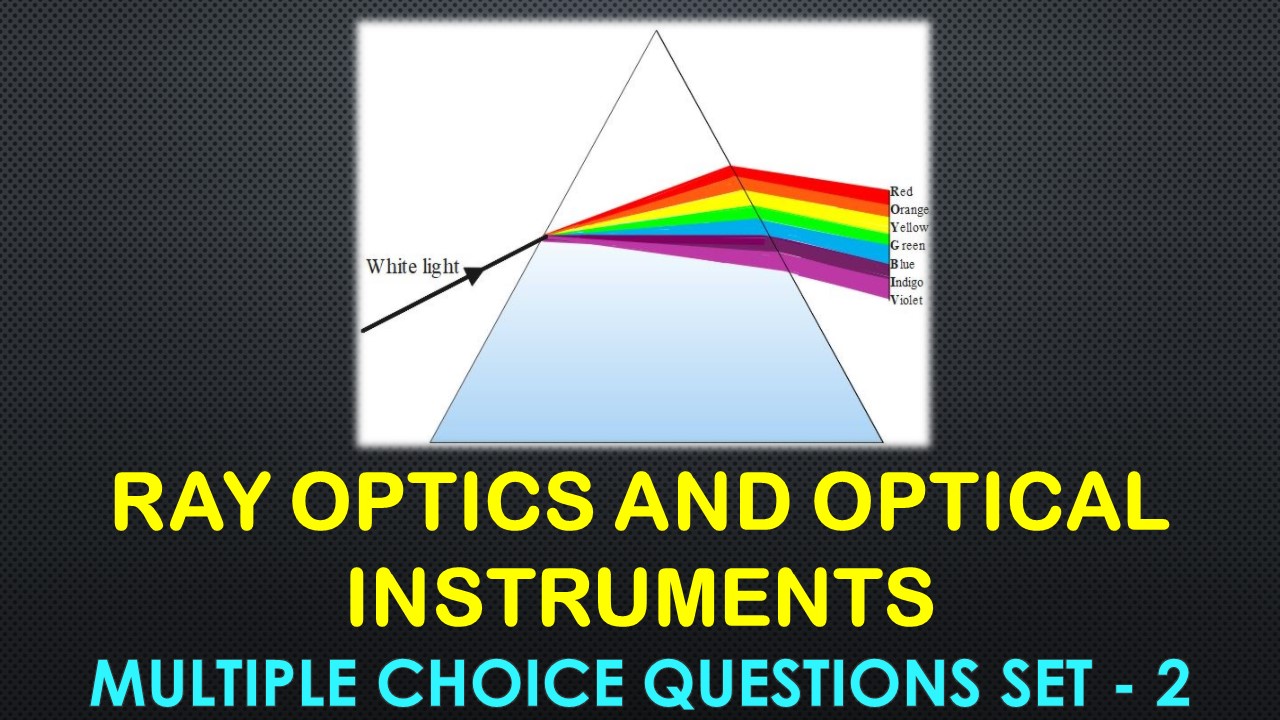CBSE Class 12 Ray Optics and Optical Instruments Multiple Choice Questions with Answers. MCQ Questions Class 12 Ray Optics and Optical Instruments with Answers Is Prepared Based on Latest Exam Pattern. Students can solve NCERT Class 12 Ray Optics and Optical Instruments MCQs with Answers to know their preparation level.
Students who are searching for NCERT MCQ Questions for Class 12 Ray Optics and Optical Instruments with Answers are compiled here to get good practice on all fundamentals. Know your preparation level on MCQ Questions for Class 12 Ray Optics and Optical Instruments with Answers. You can also verify your answers from our provided MCQ Class 12 Ray Optics and Optical Instruments with Answers. So, ace up your preparation with MCQ of Class 12 Physics Examinations.
MCQ Questions Class 12 Ray Optics and Optical Instruments with Answers - Set - 2
Question 1:
Which of the following is used in optical fibres?
(a) total internal reflection
(b) scattering
(c) reflection
(d) interference.
Correct Answer – (A)
Question 2 :
Which of these statements is correct about rainbow?
(a) In primary rainbow, red colour is on the outside and violet colour is on the inside.
(b) In primary rainbow, violet colour is on the outside and red colour is on the inside.
(c) In secondary rainbow, light wave suffers one total internal reflection before coming out.
(d) secondary rainbow is brighter than primary rainbow,
Correct Answer – (A)
Question 3 :
For a telescope, larger the diameter of the objective lens,
(a) smaller is the resolving power
(b) greater is the resolving power
(c) greater is the magnifying power
(d) smaller is the magnifying power.
Correct Answer – (B)
Question 4 :
A person can see objects only at a distance greater than 40 cm. He is avised to use lens of power:
(a) – 2.5 D
(b) + 2.5 D
(c) -6.25 D
(d) +1.5 D
Correct Answer – (D)
Question 5 :
A double convex thin lens, made of glass (µ = 1.5) has both radii of curvature of magnitude 20 cm. Incident light rays parallel to principal axis of the lens will converge at a distance L such that:
(a) L = 20 cm
(b) L = 10 cm
(c) L = 20/3
(d) L = 40 cm
Correct Answer – (A)
MCQ Questions Class 12 Ray Optics and Optical Instruments with Answers
Question 6 :
The objective of an astronomical telescope has a large aperture to:
(a) reduce spherical aberration.
(b) increase span of observation.
(c) have high resolution.
(d) have low dispersion.
Correct Answer – (C)
Question 7 :
If a glass rod is immersed in a liquid of the same refractive index, then it will:
(a) look bent
(b) look longer
(c) disapper
(d) none of these.
Correct Answer – (C)
Question 8 :
A person cannot see clearly at distance less than 2m from the eye. The power of the lens needed by him to see clearly at a distance of 0.25 m will be
(a) +1 D
(b) -1 D
(c) +3.5 D
(d) -3.5 D
Correct Answer – (C)
Question 9 :
A lens has a power of 10 D when placed in air. When it is immersed in water, (µ = 1.333), the change in power is (R.I. of lens material is 1.5):
(a) 2.55 D
(b) + 7.45 D
(c) – 7.5 D
(d) 5.0 D
Correct Answer – (C)
Question 10 :
A beam of monochromatic blue light of wavelength 4,200 A° in air travels in water (µ = 4/3) . Its wavelength in water will be
(a) 2800 Å
(b) 5600 Å
(c) 3150 Å
(d) 4000 Å
Correct Answer – (C)
- NCERT Solutions Class 11 Chemistry Chapter 1 : Some Basic Concepts of Chemistry
- NCERT Solutions Class 11 Chemistry Chapter 2 : Structure Of The Atom
- NCERT Solutions Class 11 Chemistry Chapter 3 : Classification of Elements and Periodicity in Properties
- NCERT Solutions Class 11 Chemistry Chapter 4 : Chemical Bonding and Molecular Structure
- NCERT Solutions Class 11 Chemistry Chapter 5 : States of Matter
- NCERT Solutions Class 11 Chemistry Chapter 6 : Thermodynamics
- NCERT Solutions Class 11 Chemistry Chapter 7 : Equilibrium
- NCERT Solutions Class 11 Chemistry Chapter 8 : Redox Reactions
- NCERT Solutions Class 11 Chemistry Chapter 9 : Hydrogen
- NCERT Solutions Class 11 Chemistry Chapter 10 : The s-Block Elements
- NCERT Solutions Class 11 Chemistry Chapter 11 : The p-Block Elements
- NCERT Solutions Class 11 Chemistry Chapter 12 : Organic Chemistry: Some Basic Principles and Techniques
- NCERT Solutions Class 11 Chemistry Chapter 13 : Hydrocarbons
- NCERT Solutions Class 11 Chemistry Chapter 14 : Environmental Chemistry




